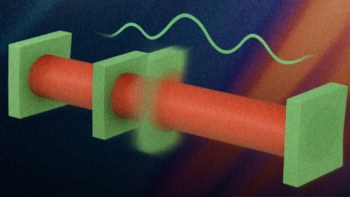
A quantum analogue of the popular “Newton’s cradle” toy has been proposed by a duo of physicists in Italy. Like momentum transferred in the toy, the team argues that it should be possible to achieve the nearly perfect transmission of a quantum wavefunction along a line of ultracold atoms in a 1D Bose–Einstein condensate. According to the pair, the work could help develop quantum-information systems that achieve high-quality wave transmission.
Best described as an “executive desk toy”, a Newton’s cradle is a device that demonstrates the conservation of energy and momentum. It consists of small, identically sized metal balls suspended from two horizontal bars. When a ball is lifted and allowed to fall, it strikes its immediate neighbour and comes to a stop. But its momentum is transferred across the rest of the spheres and propels only the sphere at the opposite end of the line into the air.
Ultracold cradling
Roberto Franzosi of the Quantum Science and Technology Institute in Arcetri and the National Institute of Optics, National Research Council, along with colleague Ruggero Vaia from the National Institute for Complex Systems, National Research Council in Florence, became interested in the quantum Newton’s cradle as part of their work on the unusual dynamics of locally perturbed quantum states. Franzosi points out that they based their design on ultracold atoms because it is one of the most versatile quantum systems from an experimental point of view. “Cold atoms are considered an excellent test bench for a huge variety of quantum phenomena,” says Franzosi, explaining that “with a suitable set-up, it is possible to realize a [quasi]-perfect transmission of the quantum wavefunction.”
Franzosi’s proposal is not the first though – a similar experiment was done in 2006 by a separate group of researchers that also attempted to create a quantum Newton’s cradle. Franzosi says that although that experiment was “a fascinating demonstration of how coherent states are the quantum analogue of classical particles”, it still did not represent a perfect analogue. That is because it was not a 1D system made up of individual quantum systems (an analogue of the rigid spheres) with nearest-neighbour interaction between them (the analogue of collisions between the spheres).
To create a perfect analogue, Franzosi and Vaia propose beginning with a Bose–Einstein condensate of two atomic species – that is, atoms in two excited states. The atoms are trapped in a 1D tube that has a longitudinal optical lattice running through it. Franzosi says that such a confinement can be created using counter-propagating laser beams that form standing waves to trap the atoms, thus developing two macroscopically populated coherent states.
“Fermionized” bosons?
The system would then be kept in a strong “Tonks–Girardeau regime” – a special type of strongly correlated quantum system that was proposed nearly 50 years ago but only experimentally realized in 2004. In such a gas, normally strongly interacting bosons, which have repulsive interactions, are confined in a 1D ensemble. Thanks to the strong repulsion, the bosons do not occupy the same position in space, effectively mimicking the Pauli exclusion principle for fermions to the point where a “fermionized” Bose gas is formed. Such a gas then exhibits many fermionic properties – such as a fermionic density distribution – with the exception of momentum distribution, which does not show ideal fermionic quantum behaviour.
In the Tonks–Girardeau regime, the strong repulsive interactions prevent double occupancy at any lattice site. This ensures that each site contains one atom and that the wavefunction is a superposition of the two hyperfine atomic states. Furthermore, the ensemble retains its characteristic momentum distribution. Once the atoms are arranged in this way, a disturbance of the wavefunction is triggered using a laser pulse coupled with the hyperfine atomic states at a given site.
“We have shown that the tunnelling between sites makes the system equivalent to a free-fermion gas on a finite lattice,” says Franzosi. So, a disturbance of the wavefunction begins bouncing back and forth from the ends, just like the outermost two spheres in a Newton’s cradle. The researchers say that the experiment associates the propagation of a wavefunction disturbance with the transmission of mechanical momentum.
While Franzosi believes that the experiment proposed is feasible, “nevertheless, I’m a theoretician and I don’t have the opportunity to carrying it out”, he says. Although both he and Vaia feel that experimentally realizing their quantum cradle would be worthwhile for the “insight it would give into the entangled beauty of quantum mechanics”, they point out that such systems could have future applications in everything from atomic interferometers to quantum memories and even a quantum communications channel. The researchers are now working on an analogue of the Mach–Zehnder interferometer – a device that is used to determine relative variations in the phase shift between two collimated beams that are obtained from a single source – using cold atoms in a similar set-up.
The research is published in Journal of Physics B.




